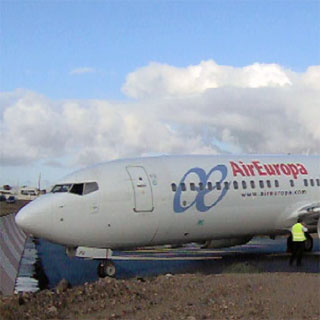Air Europa flight UX196 departed from Glasgow at 03:15 for Lanzarote with 74 passengers onboard. The flight was scheduled to last 4 hours and 19 minutes. The copilot (FO) was the pilot flying (PF). The climb and cruise flight phases at Flight Level (FL) 390 transpired without incident. Four minutes before initiating the descent to Lanzarote, the captain was resting in his seat while the FO listened to the Lanzarote ATIS (Automatic Terminal Information Service), which reported that runway 03 was in use and that weather conditions were good. Shortly thereafter they were cleared by Casablanca Control to descend to FL250 and to change frequency to Canaries Control, who in turn cleared them to continue descending to FL130 and proceed on STAR (standard arrival) TERTO 1P, as specified in the flight plan and whose information had been input into the flight management computer (FMC). The descent was started in automatic mode from the TOD (top of descent), as calculated by the FMC.

Air Europa – B737-800 (EC-HJQ) flight UX196
Immediately afterwards the FO held a detailed approach briefing for runway 03. Once at FL210, they were transferred to the Canaries Approach frequency. The FO changed frequency and, at the captain’s request, asked about the possibility of using runway 21. About two minutes later they were cleared to proceed to the fix at mile 11 on the runway 21 final at Lanzarote. At that time they were at an altitude of 14,600 ft and 30.5 nautical miles (NM) away from the runway 21 threshold. The FO then started to reprogram the FMC, but had difficulty finding the point to which they had been routed, which resulted in a delay of almost two minutes. In the meantime, the captain prompted him to descend more, though at no time did he himself manipulate any of the airplane’s controls. They were 21 NM from the runway 21 threshold and had an indicated airspeed (IAS) of 315 kt when they reached the altitude of 10,000 ft. During the last 1,000 ft, the enhanced ground proximity warning system (EGPWS) was repeatedly issuing “SINK RATE”, “PULL UP” and “TOO LOW TERRAIN” warnings.
The crew did not respond adequately to the EGPWS warnings that were issued between the altitudes of 900 ft and 80 ft.
They flew over the runway 21 threshold at a radioaltitude (RA) of approximately 180 ft, with an IAS of 175 kt (Vref+41) and the flaps deployed to an intermediate position of 25°, as a result of the “flap load relief” mechanism. As the captain stated later, he realized that the landing was going to be long and that the runway was wet. That is why he decided to increase the selected thrust on the autobrake system from the number 2 position that was initially set to the maximum (MAX) position. After a prolonged flare, the airplane touched the runway at about its halfway point, some 1,300 m from the 21 threshold and at a speed of 157 kt (Vref+23). The autobrake was disengaged five seconds after touchdown. Maximum manual braking was applied from that point on. The reversers were not engaged until 13 seconds after touchdown, and the engines were unable to reach sufficient rpm’s until the airplane had practically come to a full stop. The airplane ran off the end of the runway at a ground speed (GS) of 51 kt and traveled over the 60 m of the stopway, before stopping approximately one meter away from the 03 threshold jet blast barrier, alongside the airport’s perimeter fence. The control tower immediately alerted emergency services, which quickly arrived at the airplane’s location, though their intervention was not necessary. The passengers disembarked via the aft left door (L2) using an external ladder, after which they were then taken to the airport terminal. None of them required medical assistance.
The cause of the incident was a high-energy unstabilized approach followed by a landing with excessive speed, 1300 m past the threshold, with a wet runway. In addition, neither the autobrake nor the reversers was used efficiently. A contributing factor to the incident was a combination of deficiencies involving several aspects of CRM (Crew Resource Management).

0 Comments